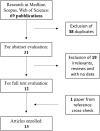D-Dimer Concentrations and COVID-19 Severity: A Systematic Review and Meta-Analysis
- PMID: 32903841
- PMCID: PMC7438945
- DOI: 10.3389/fpubh.2020.00432
D-Dimer Concentrations and COVID-19 Severity: A Systematic Review and Meta-Analysis
Abstract
Coronavirus disease 2019 (COVID-19) is a recently described infectious disease caused by severe acute respiratory syndrome coronavirus 2 (SARS-CoV-2). Since late 2019, COVID-19 has rapidly spread in virtually all countries, imposing the adoption of significant lockdown and social distancing measures. The activation of the coagulation cascade is a common feature of disseminated intravascular coagulation and adverse clinical outcomes in COVID-19 patients. In this study, we conducted a meta-analysis aiming to investigate differences in serum D-dimer concentrations in patients with and without severe COVID-19 disease. An electronic search in Medline (PubMed), Scopus and Web of Science was performed with no language restrictions, and 13 articles were reporting on 1,807 patients (585, 32.4% with severe disease) were finally identified and included in the meta-analysis. The pooled results of all studies revealed that the D-dimer concentrations were significantly higher in patients with more severe COVID-19 (SMD: 0.91 mg/L; 95% CI, 0.75 to 1.07 mg/L, p < 0.0001). The heterogeneity was moderate (I2 = 46.5%; p = 0.033). Sensitivity analysis showed that the effect size was not modified when any single study was in turn removed (effect size range, 0.87 mg/L to 0.93 mg/L). The Begg's (p = 0.76) and Egger's tests (p = 0.38) showed no publication bias. In conclusion, our systematic review and meta-analysis showed that serum D-dimer concentrations in patients with severe COVID-19 are significantly higher when compared to those with non-severe forms.
Keywords: COVID-19; D-dimer; SARS-CoV-2; coagulation; thrombosis.
Copyright © 2020 Paliogiannis, Mangoni, Dettori, Nasrallah, Pintus and Zinellu.
Figures





Similar articles
-
INR and COVID-19 severity and mortality: A systematic review with meta-analysis and meta-regression.Adv Med Sci. 2021 Sep;66(2):372-380. doi: 10.1016/j.advms.2021.07.009. Epub 2021 Jul 21. Adv Med Sci. 2021. PMID: 34315012 Free PMC article.
-
Serum Complement C3 and C4 and COVID-19 Severity and Mortality: A Systematic Review and Meta-Analysis With Meta-Regression.Front Immunol. 2021 Jun 7;12:696085. doi: 10.3389/fimmu.2021.696085. eCollection 2021. Front Immunol. 2021. PMID: 34163491 Free PMC article.
-
Hemostatic System (Fibrinogen Level, D-Dimer, and FDP) in Severe and Non-Severe Patients With COVID-19: A Systematic Review and Meta-Analysis.Clin Appl Thromb Hemost. 2021 Jan-Dec;27:10760296211010973. doi: 10.1177/10760296211010973. Clin Appl Thromb Hemost. 2021. PMID: 34933579 Free PMC article.
-
Cholesterol and Triglyceride Concentrations, COVID-19 Severity, and Mortality: A Systematic Review and Meta-Analysis With Meta-Regression.Front Public Health. 2021 Aug 18;9:705916. doi: 10.3389/fpubh.2021.705916. eCollection 2021. Front Public Health. 2021. PMID: 34490188 Free PMC article.
-
Relationship of D-dimer with severity and mortality in SARS-CoV-2 patients : A meta-analysis.Int J Lab Hematol. 2021 Feb;43(1):110-115. doi: 10.1111/ijlh.13336. Epub 2020 Sep 15. Int J Lab Hematol. 2021. PMID: 32931146
Cited by
-
Low versus high dose anticoagulation in patients with Coronavirus 2019 pneumonia at the time of admission to critical care units: A multicenter retrospective cohort study in the Beaumont healthcare system.PLoS One. 2022 Mar 24;17(3):e0265966. doi: 10.1371/journal.pone.0265966. eCollection 2022. PLoS One. 2022. PMID: 35325001 Free PMC article.
-
Systemic inflammation index, disease severity, and mortality in patients with COVID-19: a systematic review and meta-analysis.Front Immunol. 2023 Jun 21;14:1212998. doi: 10.3389/fimmu.2023.1212998. eCollection 2023. Front Immunol. 2023. PMID: 37415980 Free PMC article.
-
Correlation of Biomarkers of Endothelial Injury and Inflammation to Outcome in Hospitalized COVID-19 Patients.J Clin Med. 2022 Dec 15;11(24):7436. doi: 10.3390/jcm11247436. J Clin Med. 2022. PMID: 36556051 Free PMC article.
-
Lung Perfusion Scintigraphy Early After COVID-19: A Single-Center Retrospective Study.J Nucl Med Technol. 2021 Dec;49(4):320-323. doi: 10.2967/jnmt.121.262440. Epub 2021 Jul 30. J Nucl Med Technol. 2021. PMID: 34330803 Free PMC article.
-
Routine Hematological Parameters May Be Predictors of COVID-19 Severity.Front Med (Lausanne). 2021 Jul 16;8:682843. doi: 10.3389/fmed.2021.682843. eCollection 2021. Front Med (Lausanne). 2021. PMID: 34336889 Free PMC article.
References
Publication types
MeSH terms
Substances
LinkOut - more resources
Full Text Sources
Medical
Miscellaneous

